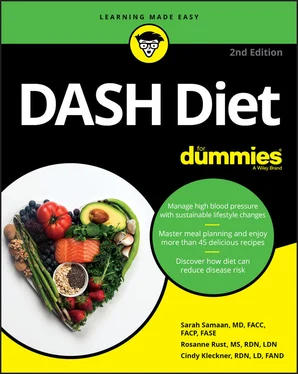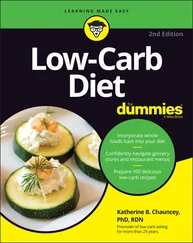Keep a vegetable snack box in the fridge too. Put sliced celery sticks, sweet bell pepper slices, and mini carrots into a zippered bag and keep it in sight when you open the refrigerator. Use these as snacks before dinner or pack them in your lunch. Dip them into a yummy Greek yogurt dip and enjoy.
Keep bananas on the counter where you can see them and easily grab one on the go. Eat one each day, before they go brown (although those make great DASH muffins). Add them to oatmeal or yogurt or just eat them as is for a quick snack.
Wash and freeze stemmed grapes for a refreshing snack in warmer months, or try cutting a banana into 1-inch chunks, dipping one end in melted dark chocolate, and freezing — a delicious, potassium-filled frozen treat!
Swap the salt-ridden taquitos that may have once inhabited your freezer for frozen fruits and vegetables — a quick and economical choice.
Spread peanut butter lightly onto whole-wheat toast or an oat bran English muffin and top with sliced strawberries or bananas and a sprinkling of flax seed for a midday snack.
Make a yogurt parfait with nonfat plain Greek yogurt, 2 tablespoons granola, and fresh fruit.
Cook spinach the night you bring it home, even if you don’t eat it then. Cooked spinach lasts a few more days in the refrigerator and is easy to reheat in a microwave or saucepan and add to eggs or a pasta or rice dish. You can also cook half of it and use the rest as sandwich toppers for your lunches. Spinach only takes about 5 minutes to cook. Bring a large pot of water to a boil, add the spinach, cover, let simmer for 2 to 3 minutes, and drain. You can also sauté it with onion and garlic in a smidge of healthy olive oil.
Keep dried fruits such as apricots, raisins, and cranberries on a prime pantry shelf for a quick snack or to add to salads and other recipes.
Mix up a fruit smoothie for breakfast or for an after-work snack while you’re getting dinner together. Place 1 cup of frozen or fresh berries or a frozen banana into a high-speed blender with ½ cup of Greek yogurt (if you’re using fresh fruit, pop in two to three ice cubes). Blend until smooth.
Keep canned beans and canned tomato products on hand. Some of these items are higher in sodium, but they’re loaded with important antioxidants. And you can remove some of the sodium by rinsing and draining beans before using.
Keep frozen peas or other no-salt vegetable blends on hand for a quick side dish or to add to pasta or rice dishes.
When you first glanced at the DASH diet, you may have said out loud: “What? Eat 4 to 5 servings of vegetables every day? And eat 4 to 5 servings of fruit too?!” But alas, friends, there is comfort in the answer to the question “What is a serving?” Table 4-1gives you the lowdown.
TABLE 4-1Serving Sizes of Fruits and Vegetables
| Food |
1 Serving |
| Apple, orange, peach, pear |
1 medium |
| Kiwifruit |
1 |
| Banana, medium-large |
½ |
| Raisins, dried cranberries, dried cherries |
¼ cup (or 4 tablespoons) |
| Frozen, canned, or fresh mixed fruit |
½ cup |
| Fruit juice |
6 ounces |
| Raw vegetables |
1 cup |
| Cooked vegetables |
½ cup |
| Low-sodium vegetable juice |
6 ounces |
So with the information in Table 4-1, you know that if you slice up a large apple or a large banana for your midday snack, you can count that as 2 servings. Most dinner salads at restaurants are also 2 servings. Add 4 tablespoons of dried fruit to that salad and you’ve got another serving of fruit. Throw 1 cup of frozen strawberries into the blender with some low-fat yogurt and you just included another serving of fruit! See how easy this 4-to-5 servings rule is?
 In addition to the fruit and vegetable groups, you want to add nuts, seeds, and dried beans to your diet. These high-protein foods are considered to be part of the meat/protein food group. In addition to protein, they provide nutrients and fiber. Serving sizes are important here too. Just ⅓ cup of nuts equals 1 serving. A serving of seeds is just 2 tablespoons, and a serving of beans is ½ cup.
In addition to the fruit and vegetable groups, you want to add nuts, seeds, and dried beans to your diet. These high-protein foods are considered to be part of the meat/protein food group. In addition to protein, they provide nutrients and fiber. Serving sizes are important here too. Just ⅓ cup of nuts equals 1 serving. A serving of seeds is just 2 tablespoons, and a serving of beans is ½ cup.
Decreasing the amount of saturated fat, cholesterol, and sodium
In general, you should choose less packaged, processed food. The DASH diet is low in saturated fat, so keep an eye out for the amounts you see on food labels. Look for foods that have less than 1.5 grams of saturated fat per serving. DASH is also low in cholesterol and total fat and limits sugary foods and beverages.
The DASH diet is lower in sodium, recommending no more than 2,300 milligrams per day. The 2010 dietary guidelines for Americans advise people who already have high blood pressure, or have diabetes or kidney disease, to consume no more than 1,500 milligrams of sodium per day. This guideline also applies to middle-aged or older adults. Younger, healthy folks can handle a bit more sodium, but staying under 2,300 milligrams per day is a good bet. However, even with sodium levels at around 3,000 milligrams a day, when all other DASH guidelines were employed, blood pressure was still reduced. Still, the DASH research shows that eating plans that are lower in sodium lower blood pressure even more. Table 4-2shows the breakdown of various nutrients used in the DASH studies.
Of course, because one of the goals of the DASH diet is also to maintain a healthy body weight, you must figure out how many calories you need. To lose weight, you must create a calorie deficit. See the sidebar “ How many calories do you need?” for help calculating the amount of calories needed to maintain your weight.
TABLE 4-2Daily Nutrient Goals Used in DASH Diet Studies
| Macronutrient |
Percentage of Daily Calories |
| Total fat |
27% |
| Saturated fat |
6% |
| Protein |
18% |
| Carbohydrate |
55% |
| Nutrient |
Amount |
| Cholesterol |
150 milligrams (mg) |
| Sodium |
2,300 mg |
| Potassium |
4,700 mg |
| Calcium |
1,250 mg |
| Magnesium |
500 mg |
| Fiber |
30 grams |
Source: National Heart, Lung, Blood Institute
Creating Goals for Dietary Change
Imagine a stronger, healthier you. Visualizing yourself accomplishing your new diet and exercise goals is one way to begin the goal-setting process. Consider writing down some of the aspects of your vision. For example: I will feel better, I will be more fit, I will look great in new clothes, I will have more energy, I will learn more about myself as I keep a daily journal, and so on.
After you’ve visualized yourself living a healthier lifestyle, you can start setting the goals that will ultimately help you get there. For the best chance at success, keep your goals specific and realistic. You also need to track your progress toward your goals to hold yourself accountable. We help you do both in the next sections.
SMART goals are Specific, Measurable, Attainable, Realistic, and Timely. What does all that mean, exactly? Well, the specific aspect is pretty self-explanatory. Instead of setting a bunch of general goals, give yourself specific ones that you can better hold yourself accountable to. We list some examples in Table 4-3.
TABLE 4-3Setting Specific Goals
| General Goal |
Specific Goal |
| I will eat more fruit. |
I will pack an apple or orange every day for work. |
| I will lose weight. |
I will record my daily food intake and follow my meal plan, working toward a 10- to 20-pound weight loss over the year. |
| I will eat more vegetables. |
I will have a variety of fresh, frozen, and low-sodium canned vegetables on my weekly grocery list and try a new recipe each week that includes them. |
| I will exercise more. |
I will schedule a workout for an hour every Tuesday and Thursday right after work. |
| I will eat out less often. |
I will cook dinner at home at least four days a week using simple recipes from this book. |
Specific goals are more measureable. Measureable goals are easier to track and help you visualize your progress. Work on one or two measurable goals at a time. To measure some of the goals from Table 4-3, simply keep a journal for the week. Let’s say your initial goal is to eat 3 servings of fruit daily. You can easily measure that by recording your intake daily and comparing it to the goal.
Читать дальше

 In addition to the fruit and vegetable groups, you want to add nuts, seeds, and dried beans to your diet. These high-protein foods are considered to be part of the meat/protein food group. In addition to protein, they provide nutrients and fiber. Serving sizes are important here too. Just ⅓ cup of nuts equals 1 serving. A serving of seeds is just 2 tablespoons, and a serving of beans is ½ cup.
In addition to the fruit and vegetable groups, you want to add nuts, seeds, and dried beans to your diet. These high-protein foods are considered to be part of the meat/protein food group. In addition to protein, they provide nutrients and fiber. Serving sizes are important here too. Just ⅓ cup of nuts equals 1 serving. A serving of seeds is just 2 tablespoons, and a serving of beans is ½ cup.










